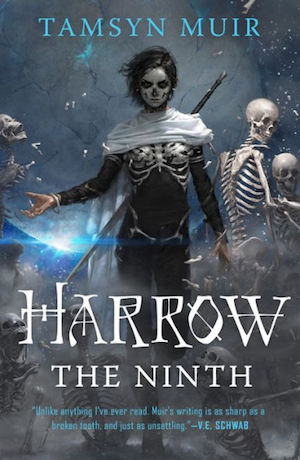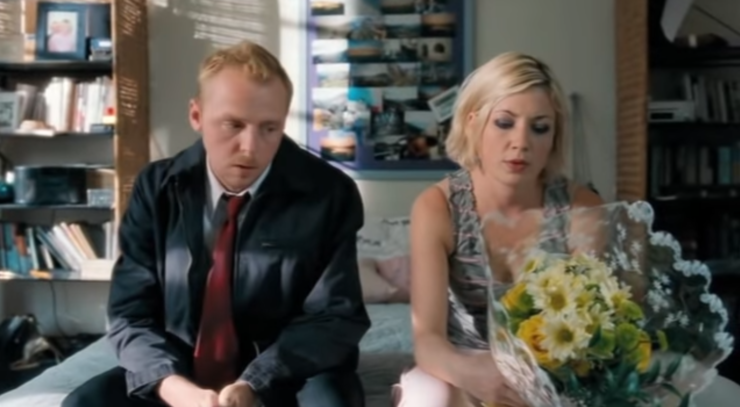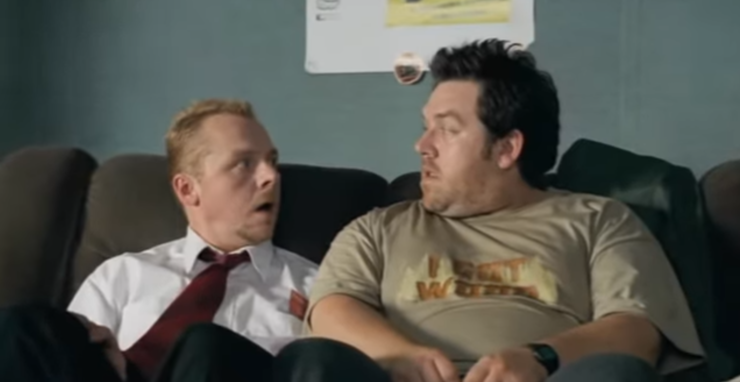Edgar Wright’s 2004 big budget film debut Shaun of the Dead is widely praised as a masterful and loving tribute to the zombie movie. It’s also, though, a critique, or at least a gentle questioning, of the genre’s misanthropy and pessimism. If you’re looking for a film to make you feel good about failures of personal hygiene while sitting at home during a global pandemic and catastrophe, you won’t find one more committed to letting you be you, in all your slovenliness, than Shaun of the Dead.
The iconic promotional poster for Shaun shows star and co-writer Simon Pegg in a train car stuffed with the undead. “Ever felt like you were surrounded by zombies?” the copy asks, as Pegg looks out half-confused and half-disgruntled.
“Zombies are humans” is the central joke of the movie, and not coincidentally of the zombie genre itself. People are zombies, zombies are people, and we’re surrounded by both. George Romero’s Dawn of the Dead (1978) is set in a shopping mall, where the zombies stagger onto escalators, fall into fountains, and lurch through store aisles, brainlessly consuming corporate crap and each other, just as they did in life. Even before we’re walking dead, we’re walking dead. Zombies are a bleak satire of the pointless appetite of human existence. We devour each other and die, in a barely sentient orgy of brainless desire.
Buy the Book


Harrow the Ninth
Wright riffs on this zombified quality of humans through the early part of Shaun by introducing zombie visual tropes before anyone is actually turned into a zombie. The opening title sequence (set to the song “The Blue Wraith” by I Monster) is a brilliant pan across a zombie-like working class London. An elderly man pushing shopping carts at the supermarket; a line of cashiers with eyes half closed checking people out in sluggish unison; men walking down an alley with their heads lolling as if drugged or dead; a kid repetitively kicking a soccer ball. The sequence ends with a shot of the legs of Shaun (Simon Pegg), twisted inward and jerking forward towards the camera. There’s a mighty, deathlike groan before Wright’s deft camera pans up to show Shaun emitting a grotesque yawn.
Shaun doesn’t just groan and shuffle like a zombie; he wanders through his life like one. He’s buried in his own routine, dragging himself from his flat to his bleakly meaningless sales job to the local pub like a neuronless dead thing. His most intense personal relationship is with his roommate Ed (Nick Frost)—introduced with a wickedly funny horror movie pull-back screen reveal—who spends his days on the couch farting, playing video games, and refusing to take down Shaun’s phone messages. Shaun’s girlfriend Liz (Kate Ashfield), desperately wants to occasionally do something with her boyfriend other than go to the Winchester pub every night. But he can’t even get his act together enough to make dinner reservations, or to introduce her to his mom and stepfather even though they live in the city and Shaun’s been dating Liz for three years.
Zombies are disgusting, and if humans are zombies, then humans are disgusting too—and there is something viscerally repulsive about Shaun’s aggressive haplessness. All he has to do is make a minimal effort, but he just refuses, choosing instead to snigger at Ed’s orangutan impression for the 400th time, or just drink himself into a stupor. Shaun’s so mired in his own zombieness he doesn’t even notice when everyone around him starts turning into gaping, groaning undead. Ed is even worse; when Shaun is attacked by a zombie, Ed runs off to get a camera so that he can take a picture of the assault. He’s a bad friend and a bad person, yet Shaun seems to relish the abuse Ed tosses his way. “Shaun!’ you want to shout at the screen. “Wake up! Or at least get eaten!”
That’s a familiar impulse. Zombie movies not infrequently get you to root for the relatively active zombies against the gormless humans. Everyone wants cowardly Harry Cooper (Karl Hardman) to get it in Night of the Living Dead, and in general zombie films are an exercise in waiting for the defenses to be overrun and the walls breached in a satisfying apocalypse of teeth and meat.
Wright, though, raises the specter of misanthropy only to smash it in the head with a cricket bat—or with a different genre. Specifically, Wright picks up the rom-com (the tagline for Shaun of the Dead was “A Romantic Comedy with Zombies”) so he can bludgeon zombies with it.

If the zombie genre feeds into the idea that people are terrible and vile and deserve death, the rom-com is all about encouraging commitment-phobes to embrace sociability, as they find kindness and lovability in themselves and others. And Shaun is essentially a rom-com response to the zombie movie presupposition that humans and zombies are despicable or beyond redemption.
Thus, Shaun starts out the film hating his stepfather, the cadaverous Philip (Bill Nighy). Philip first appears waiting outside Shaun’s work, looming zombie-like through the glass, a horror-film antagonist reminding Shaun to buy flowers for his mother and not to be such a loser. Shaun and Ed fantasize about him turning into a zombie so they can bash his brains in.
But after Philip is bitten, and before he turns, he tells Shaun that he loves him, and that he always thought Shaun was a strong and good person. Before this point Shaun has told everyone who will listen that Philip is “not my dad, he’s my stepdad!” But the last time Shaun says Philip isn’t his dad, it’s because Philip’s dead. The scene is perhaps the film’s most moving, precisely because it draws a distinction between humans and the dead. Philip wasn’t a zombie; he wasn’t just a disgusting body out to destroy Shaun. He was a good guy, and now he isn’t, and Shaun is left to wish he’d realized his dad, the not-a-zombie, was worth loving earlier.
Shaun and Liz also put their relationship on a stronger footing by the end of the film, but the real romantic core of the movie is the bromance between Shaun and Ed. Ed is, everyone agrees, holding Shaun back with his zombie-ish lack of ambition and general vileness. During the apocalypse they have a fight when Ed answers a phone call and starts discussing weed sales while the zombies are closing in.
But then Ed gets bitten. At first, this seems like a tragedy, with Shaun and Ed making their last tearful goodbyes. But the final scene of the film, set several weeks later after the apocalypse is controlled, finds zombie Ed chained contentedly in Shaun and Liz’s shed. There he does much the same thing as he always did—vegging out on the couch and playing video games.
In zombie films, often, the revelation that humans are zombies is a way to reveal the grossness and loathsomeness of humans. But in Shaun of the Dead, if zombies are humans, it just shows that zombies are worth playing video games with, too. Wright’s love of zombie movies finds expression in a very un-zombie-movie-like love of the whole world, and all the zombies in it. At a time when large numbers of people are sitting home, not doing much, Shaun of the Dead insists that sitting home and not doing much is totally fine. We’re all lurching, groaning, ugly smelly creatures—what’s not to love?
Noah Berlatsky is the author of Wonder Woman: Bondage and Feminism in the Marston/Peter Comics (Rutgers University Press).










